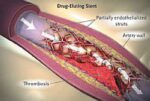Original title: Predicitors of suboptimal TIMI flow alter primary angioplasty for acute myocardial infarction: results from the HORIZON-AMI trial. Reference: Adriano Caixeta et al. Eurointervention 2013;9:220-227 Primary angioplasty showed greater efficacy than thrombolytics but one out of every four patients cannot achieve TIMI 3 flow. The Horizons-AMI trial randomized 3,602 patients to receive bivalirudin or heparin plus inhibitors...
Asymptomatic carotid injury, a disease not so silent
Original title: Association of the Recovery of Objective Abnormal CerebralPerfusion with Neurocognitive Improvement after CarotidRevascularization. Reference: Ching-Chang Huanget al. J Am CollCardiol 2013. Article in press. Cognitive impairment was observed in patients with severe asymptomatic carotid injury but a possible explanation for this is hyper-perfusion. Intuitively restored flow may improve neurocognitive capacity but so far studies have been...
Monoclonal antibodies to decrease peri-procedural myocardial damage
Original title: Effects of the P-Selectin Antagonist Inclacumab on Myocardial Damage After Percutaneous Coronary Intervention for Non–ST-Segment Elevation Myocardial Infarction Results of the SELECT-ACS Trial. Reference: Jean-Claude Tardif et al. J Am Coll Cardiol 2013;61:2048–55. The pathophysiology of myocardial injury after angioplasty is multifactorial but it is clear that inflammation and platelet activation play a major role. P-selectin...
Rational use of bivalirudin, less bleeding and less costs using risk score
Original title: Pre-Procedural Estimate of Individualized Bleeding Risk Impacts Physicians’ Utilization of Bivalirudin During Percutaneous Coronary Intervention. Reference: Seshu C. Rao et al. J Am Coll Cardiol 2013;61:1847–52 While safety of coronary angioplasty has improved over time, post-procedure bleeding is still frequent with a large variability between centers. Bleeding is associated with increased mortality, myocardial infarction, stroke, increased...
Angioplasty to common femoral artery begins to emerge as an alternative to surgery
Original title: Acute and Medium-Term Outcomes of Endovascular Therapy of Obstructive Disease of Diverse Etiology of the Common Femoral Artery. Reference: Philip B. Dattilo et al. Catheterization and Cardiovascular Interventions 81:1013–1022 (2013). Surgical endarterectomy is established as the gold standard for treating injuries to common femoral artery since angioplasty presents some difficulties due to the risk of compromising...
High doses of Rosuvastatin in acute coronary syndromes
Original title: Rosuvastatin calcium in acute coronary sydromes Reference: Aggarwal, R. et al, Expert Opinion on Pharmacotherapy , Volume 14, Number 9, June 2013 , pp. 1215-1227(13). Lowering cholesterol of low density lipoproteins (LDL-C) by reducing inhibitors of 3-hydroxy-3-metilgutaril coenzyme A (HMGCoA) statins has proven advantageous for the survival of patients with acute coronary syndrome (ACS). These patients...
Jornadas República Dominicana 2013
Las presentaciones más destacadas de las Jornadas SOLACI llevadas a cabo el 13 y 14 de junio de 2013 en Punta Cana, Rep. Dominicana
Drugs to treat high blood pressure reduce the risk of dementia
Taking beta-blockers may help reduce the risk of dementia according to a new study. Dr. Lon White of the Pacific Health Research and Education Institute in Honolulu, Hawaii, USA, who will present the data during the 65th Annual Meeting of the American Academy of Neurology in San Diego in March, described the discovery as ‘fascinating’....
Chimney technique for type B aortic dissection
Original title: The Single-centre Experience of the Supra-arch Chimney Technique in Endovascular Repair of Type B Aortic Dissections. Reference: Y. Zhu et al. European Journal of Vascular and Endovascular Surgery Volume 45 Issue 6 June/2013. Endovascular repair of type B aortic dissection (TEVAR) involving the arch, requires special techniques to preserve supra aortic vessels as fenestrated prostheses or...
Stent Thrombosis in the Real World
Original title: Incidence and predictors of stent trombosis: a single-centre study of 5833 consecutive patients undergoing coronary artery stenting Reference: Javaid Iqbal et al. EuroInterventional 2013;9:62-69 Though potentially fatal, stent thrombosis is a low frequency event associated to stent malapposition, fractures, resistance to antiplatelet therapies, and diseases such as diabetes and kidney disease, among other factors. 5883 pacients...









